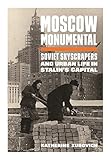Moscow Monumental : Soviet Skyscrapers and Urban Life in Stalin's Capital / Katherine Zubovich.
Material type: TextPublisher: Princeton, NJ : Princeton University Press, [2020]Copyright date: ©2021Description: 1 online resource (288 p.) : 70 b/w illusContent type:
TextPublisher: Princeton, NJ : Princeton University Press, [2020]Copyright date: ©2021Description: 1 online resource (288 p.) : 70 b/w illusContent type: - 9780691205298
- Architecture and society -- Russia (Federation) -- Moscow
- Architecture -- Composition, proportion, etc
- Communism and architecture -- Russia (Federation) -- Moscow
- Skyscrapers -- Russia (Federation) -- Moscow
- HISTORY / Russia & the Former Soviet Union
- Heather DeHaan
- Hilton Moscow Leningradskaya Hotel
- Hotel Ukraina
- Joseph Stalin
- Katherine Lebow
- Kotelnicheskaya Embankment Apartments
- Kudrinskaya Square Building
- Michal Murawski
- Ministry of Foreign Affairs
- Moscow State University
- Moscow’s Seven Sisters
- Nowa Huta
- Red Gates Administrative Building
- Russia
- Russian history
- Seven Sisters
- Soviet Russia
- Soviet history
- Stalinism
- Stalinist City Planning
- Stalin’s high-rises
- The Palace Complex
- Unfinished Utopia
- urbanism
- 720/.483094731 23
- online - DeGruyter
| Item type | Current library | Call number | URL | Status | Notes | Barcode | |
|---|---|---|---|---|---|---|---|
 eBook
eBook
|
Biblioteca "Angelicum" Pont. Univ. S.Tommaso d'Aquino Nuvola online | online - DeGruyter (Browse shelf(Opens below)) | Online access | Not for loan (Accesso limitato) | Accesso per gli utenti autorizzati / Access for authorized users | (dgr)9780691205298 |
Frontmatter -- Contents -- Acknowledgments -- Note on Transliteration and Abbreviations -- Introduction -- 1. Red Moscow -- 2. The Palace -- 3. The War -- 4. Moscow of the Plan -- 5. Moscow of the Shadows -- 6. The Vysotniki -- 7. The View from the Top -- 8. De-Stalinization and the Battle against “Excess” -- Epilogue -- Notes -- Bibliography -- Index
restricted access online access with authorization star
http://purl.org/coar/access_right/c_16ec
An in-depth history of the Stalinist skyscraperIn the early years of the Cold War, the skyline of Moscow was forever transformed by a citywide skyscraper building project. As the steel girders of the monumental towers went up, the centuries-old metropolis was reinvented to embody the greatness of Stalinist society. Moscow Monumental explores how the quintessential architectural works of the late Stalin era fundamentally reshaped daily life in the Soviet capital.Drawing on a wealth of original archival research, Katherine Zubovich examines the decisions and actions of Soviet elites—from top leaders to master architects—and describes the experiences of ordinary Muscovites who found their lives uprooted by the ambitious skyscraper project. She shows how the Stalin-era quest for monumentalism was rooted in the Soviet Union's engagement with Western trends in architecture and planning, and how the skyscrapers required the creation of a vast and complex infrastructure. As laborers flooded into the city, authorities evicted and rehoused tens of thousands of city residents living on the plots selected for development. When completed in the mid-1950s, these seven ornate neoclassical buildings served as elite apartment complexes, luxury hotels, and ministry and university headquarters.Moscow Monumental tells a story that is both local and broadly transnational, taking readers from the streets of interwar Moscow and New York to the marble-clad halls of the bombastic postwar structures that continue to define the Russian capital today.
Mode of access: Internet via World Wide Web.
In English.
Description based on online resource; title from PDF title page (publisher's Web site, viewed 01. Dez 2022)


